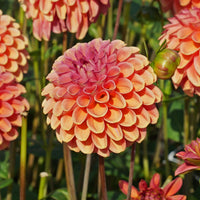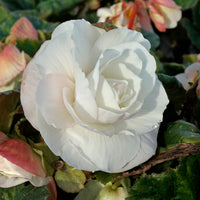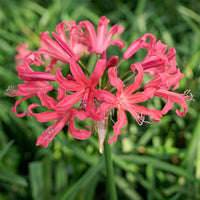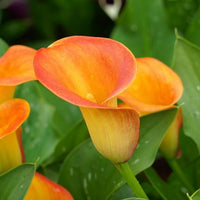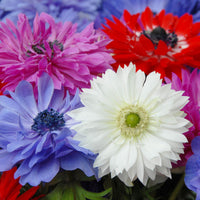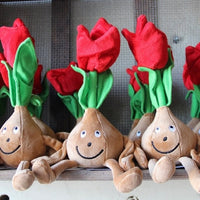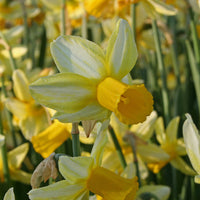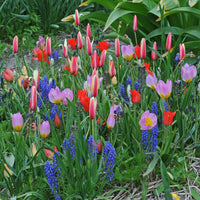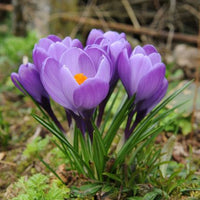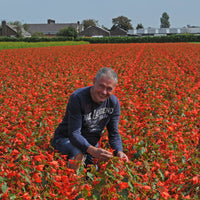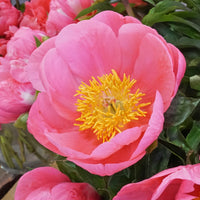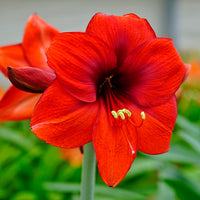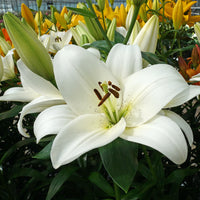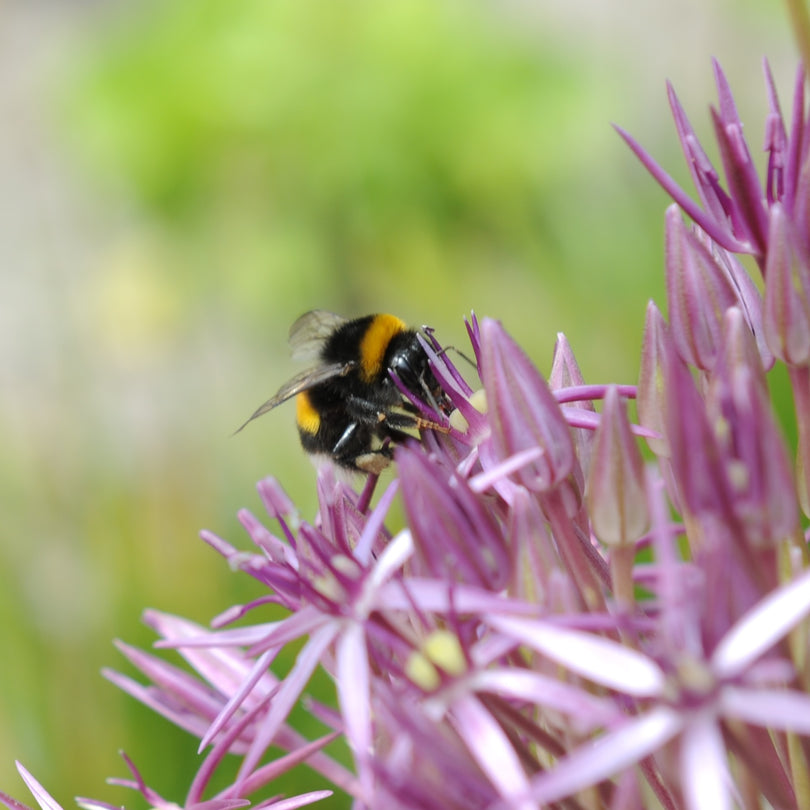Over A Week Late
 It was just a little bit of bad luck, I think. I just returned from Kazakhstan, where I was going to look at Tulips in their natural habitat. When we arrived at the airport, we already knew what we were going to see when we actually got to the countryside, because it had been around 30 degrees Celsius for quite some time then. We were right: Most Tulips had completely finished flowering. Not what we hoped for, but we knew it was a likely possibility. A bit of a flashback to the birth of my second daughter Pleun, she was over a week late as well (and born in the Spring, too). Now, we refer to anything that has to do with lateness as ‘Pleuning’.
It was just a little bit of bad luck, I think. I just returned from Kazakhstan, where I was going to look at Tulips in their natural habitat. When we arrived at the airport, we already knew what we were going to see when we actually got to the countryside, because it had been around 30 degrees Celsius for quite some time then. We were right: Most Tulips had completely finished flowering. Not what we hoped for, but we knew it was a likely possibility. A bit of a flashback to the birth of my second daughter Pleun, she was over a week late as well (and born in the Spring, too). Now, we refer to anything that has to do with lateness as ‘Pleuning’. Before you get the impression that we were just being tourists in this beautiful country, I should tell you about the most important reason for our visit. We went to Kazakhstan on a mission, and it felt like one of those old-fashioned adventurous expeditions.
Before you get the impression that we were just being tourists in this beautiful country, I should tell you about the most important reason for our visit. We went to Kazakhstan on a mission, and it felt like one of those old-fashioned adventurous expeditions. Our guide Askar with a stick insect on his arm
Our guide Askar with a stick insect on his arm
By ‘we’ I mean my good friends John and Johanna Huiberts, who are husband and wife, and our guide Askar, who has worked for John and is now studying Agriculture in The Netherlands. Johanna and John have been named in this newsletter before, so you might remember them: they are pioneers in biological flower bulb growing. You can read more at www.biologischebloembollen.nl. They grow flower bulbs without using any kind of chemicals. After years of practice and meticulous studying, they have found a way that works well, but especially for Tulips, growing them biologically remains an enormous challenge. Growing bulbs biologically starts with the soil. Healthy soil means a healthy bulb: Soil that has all the necessary nutrients and life in it can help the bulbs that are planted in it to ‘strengthen their immune system,’ which makes them much more likely to be healthy from start to finish. But no matter how hard we try, Tulips are tough to grow truly biologically. They are often just very sensitive to illnesses. Especially when they are grown on the same piece of land for more than just one year, which is also inconvenient. But there are places where Tulips have come back in the same spot for hundreds of years. Places like Kazakhstan, where they have been for centuries without any kind of interference. We started to wonder if the soil in Kazakhstan might have something to teach us about growing Tulips. There might be something there that our Dutch soil lacks. So, the mission was simple: go to Kazakhstan and take lots and lots of samples of soil where those Tulips grow, and find a way to study exactly what is inside it.
But no matter how hard we try, Tulips are tough to grow truly biologically. They are often just very sensitive to illnesses. Especially when they are grown on the same piece of land for more than just one year, which is also inconvenient. But there are places where Tulips have come back in the same spot for hundreds of years. Places like Kazakhstan, where they have been for centuries without any kind of interference. We started to wonder if the soil in Kazakhstan might have something to teach us about growing Tulips. There might be something there that our Dutch soil lacks. So, the mission was simple: go to Kazakhstan and take lots and lots of samples of soil where those Tulips grow, and find a way to study exactly what is inside it. To do that, we are collaborating with the Universities of Leiden, Utrecht, and Astana, where we met many very enthusiastic researchers who are all looking forward to this study. So, the fact that the Tulips had mostly finished blooming was no problem at all: the most important part was taking those soil samples. And don’t worry, we still saw lots of Tulips that were a bit later, as we went to many different places during our trip. We took 48 samples, if you can believe it. I am really looking forward to the results of the analysis of those samples: We will know everything about the funghi, bacteria, nutrients, and other elements that the soil there has. Our hope is that we can then use that information to biologically strengthen our soil in The Netherlands in order to (hopefully drastically) decrease the amount of chemicals used in flower bulb growing.
To do that, we are collaborating with the Universities of Leiden, Utrecht, and Astana, where we met many very enthusiastic researchers who are all looking forward to this study. So, the fact that the Tulips had mostly finished blooming was no problem at all: the most important part was taking those soil samples. And don’t worry, we still saw lots of Tulips that were a bit later, as we went to many different places during our trip. We took 48 samples, if you can believe it. I am really looking forward to the results of the analysis of those samples: We will know everything about the funghi, bacteria, nutrients, and other elements that the soil there has. Our hope is that we can then use that information to biologically strengthen our soil in The Netherlands in order to (hopefully drastically) decrease the amount of chemicals used in flower bulb growing. 48 samples may sound a bit excessive, but believe me when I say that this was extremely easy to collect in Kazakhstan. There are so many Tulips there that after the first few days we were already pretty sure that there were more Tulips in Kazakhstan than in the entire Netherlands. Our first visit was to an area that was as large as the northern part of North-Holland. We were driven around by a gentleman who worked for the local government to oversee leasing parts of that land to local cattle holders, who let their cows, sheep, and horses graze there. For hours, we drove around in his old Japanese Pajero Jeep, with the steering wheel on the wrong side of the car (at least for us). He led us to the places that had the most Tulips and he knew the sandy roads like the back of his hand.
48 samples may sound a bit excessive, but believe me when I say that this was extremely easy to collect in Kazakhstan. There are so many Tulips there that after the first few days we were already pretty sure that there were more Tulips in Kazakhstan than in the entire Netherlands. Our first visit was to an area that was as large as the northern part of North-Holland. We were driven around by a gentleman who worked for the local government to oversee leasing parts of that land to local cattle holders, who let their cows, sheep, and horses graze there. For hours, we drove around in his old Japanese Pajero Jeep, with the steering wheel on the wrong side of the car (at least for us). He led us to the places that had the most Tulips and he knew the sandy roads like the back of his hand. The first time we actually saw a Tulip we promptly drove over it: Too late. But we stopped the car and got out, and before you knew it, you had stepped on the next Tulip. All around us were Tulip petals. Not a lot of full flowers any more as most had finished blooming, but we did see that there were thousands of Tulips there. It turned out to be Tulipa zenaida, which I had never heard of. It’s a rare variety in The Netherlands, but –you guessed it–Kazakhstan is full of them. Especially that particular hill. We found a few late bloomers for photographs, but soil samples can be taken from the soil around the Tulips that have finished blooming, too: It really is about the soil surrounding the Tulip itself.
The first time we actually saw a Tulip we promptly drove over it: Too late. But we stopped the car and got out, and before you knew it, you had stepped on the next Tulip. All around us were Tulip petals. Not a lot of full flowers any more as most had finished blooming, but we did see that there were thousands of Tulips there. It turned out to be Tulipa zenaida, which I had never heard of. It’s a rare variety in The Netherlands, but –you guessed it–Kazakhstan is full of them. Especially that particular hill. We found a few late bloomers for photographs, but soil samples can be taken from the soil around the Tulips that have finished blooming, too: It really is about the soil surrounding the Tulip itself.  Our next stop was Taraz, where we attended a Tulip convention and -festival. The convention was a gathering of biologists and agricultural leaders. They were all incredibly smart and mostly concerned with finding a way to preserve the many Tulips that make Kazakhstan so beautiful this time of year. Not all species are the same, and some of them need more protection if we do not want them to go extinct. We were welcomed as if we were royalty, it was a surreal experience, but so much fun. I even got to give a very short interview for the local television network to explain how we hoped to find the answer to growing Tulips without chemicals in Kazakhstan. We even visited the Dutch Ambassador for Agriculture in Astana, which was a very interesting experience too.
Our next stop was Taraz, where we attended a Tulip convention and -festival. The convention was a gathering of biologists and agricultural leaders. They were all incredibly smart and mostly concerned with finding a way to preserve the many Tulips that make Kazakhstan so beautiful this time of year. Not all species are the same, and some of them need more protection if we do not want them to go extinct. We were welcomed as if we were royalty, it was a surreal experience, but so much fun. I even got to give a very short interview for the local television network to explain how we hoped to find the answer to growing Tulips without chemicals in Kazakhstan. We even visited the Dutch Ambassador for Agriculture in Astana, which was a very interesting experience too. The next day we decided to go to the festival I mentioned earlier. We drove through the hills for an hour, and then for another hour over a dusty sand road to go to the place where the greigii Tulips grow.
The next day we decided to go to the festival I mentioned earlier. We drove through the hills for an hour, and then for another hour over a dusty sand road to go to the place where the greigii Tulips grow.  These had finished blooming, too, but if you look closely, you can still see all the Tulip leafs all over the ground. It is completely covered in Tulips. The cars at the festival were basically parked in a Tulip field. In The Netherlands, we treat these kinds of Tulips as rare varieties, here, they are almost like dandelions. You couldn’t move your car without driving over one of them.
These had finished blooming, too, but if you look closely, you can still see all the Tulip leafs all over the ground. It is completely covered in Tulips. The cars at the festival were basically parked in a Tulip field. In The Netherlands, we treat these kinds of Tulips as rare varieties, here, they are almost like dandelions. You couldn’t move your car without driving over one of them. It was a real festival with all kinds of games. Judo, wrestling on horseback, tug-of-war, all kinds of food and those typical yurt tents set up as cute souvenir shops. To see flowers, you had to spend another hour in the car to drive even further uphill, where there were still a few of the last Tulips left in bloom. We had no time for that, unfortunately: Professor Ainash from the University of Astana had joined us on the trip, and she had to get back to Astana for her work.
It was a real festival with all kinds of games. Judo, wrestling on horseback, tug-of-war, all kinds of food and those typical yurt tents set up as cute souvenir shops. To see flowers, you had to spend another hour in the car to drive even further uphill, where there were still a few of the last Tulips left in bloom. We had no time for that, unfortunately: Professor Ainash from the University of Astana had joined us on the trip, and she had to get back to Astana for her work. Dahlia Tartan
Dahlia Tartan
Next week, I will tell you more about this unforgettable trip, because a thousand words is way too little and I also need to concern myself with actually telling you to buy our Dahlias. But luckily I don’t mind doing so, as we still have a lot of truly wonderful varieties available in our web shop. If you order summer-blooming flowers this week, you will also be rewarded with extra bulbs added to your order as a gift.
I’m going to go back outside now, as the weather here just keeps being nice to us. I need to water a lot of plants, because the rain still isn’t really coming around, but I’m not complaining about the sun we are getting. And one last fun fact for your Dahlias: Snails seem to have smaller families this year. Maybe a bit of a bummer if the snail is your favourite animal, but I myself am quite happy with it.
Kind regards,
Carlos van der Veek

